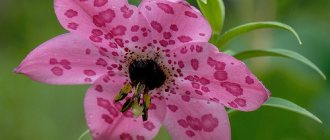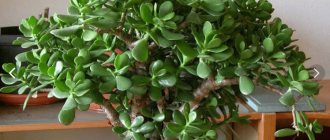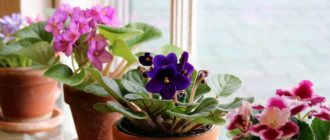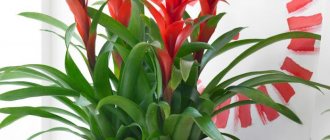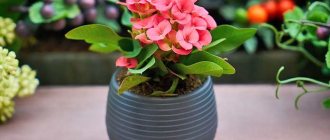Gardenia
Gardenia is an unusually elegant flower that belongs to the madder family. In terms of sophistication, it is compared to camellia. In addition to its chic appearance, it has a charming scent. Just one pot of the plant will fill the entire room with a subtle aroma.
In nature, gardenia grows on the Ryukyu Islands, as well as in the forests of Japan, India and China. It is popularly called “Cape jasmine”. Under natural conditions it reaches a height of 2 m, in rare cases – 3 m.
The leaves of the plant are dark green in color, shiny, with a dense texture and pointed tips. Indoor specimens look neat and compact, the height is 0.5 m, and are beautiful even in the absence of flowering.
The plant owes its name to A. Garden, a doctor and naturalist from America. It was he who cultivated this species.
There are specimens with white and cream flowers, regular or double. The diameter of each is up to 10 cm. The flowers are collected in inflorescences or arranged singly. They emit a pleasant aroma. Flowering occurs from July to October. Under good conditions and care, the plant becomes covered with gorgeous buds.
More than 250 species of gardenia are found in nature. However, flower growers grow only a few varieties: profuse, regal, jasmine, radicans, Kula, citriodora. In indoor conditions they contain mainly jasmine gardenia. Large double white flowers are formed on its shoots.
Here's what you should know about gardenia:
- Among flower growers it has gained fame as a demanding plant.
- Does not like rearrangements and changes in location. Until death.
- Prefers light, but gets burned when exposed to direct sunlight. The ideal place is a bright room on the south side.
- The optimal temperature is 18-22 C.
- Cold and drafts cause flowers to fall off. It has a hard time surviving sudden temperature changes.
- Avoid watering with cold water. The plant will react by yellowing the leaves.
- In a shaded place, the buds may dry out and fall off. Rooms on the north side require an additional light source.
- At temperatures above 24 C, weak shoots begin to grow, on which buds do not form.
To make friends with a flower, you will need to make an effort and customize the content. Gardenia can complement any interior. A beautiful, neat bush will decorate the room, make it cozy and fill it with a pleasant fragrance. Will be an unforgettable holiday gift.
Gloxinia
Famous perennials starting with the letter g: gardenia, hibiscus, glottiphyllum, graptopetalum. Gloxinia, which is characterized by a tuberous root system, also belongs to long-living plants.
Up to 20 species of gloxinia grow in the wild. Homeland: Brazil, tropical South America. Grows on river banks, slopes, rocks and forest clearings. The wild plant is more like a shrub or grass. Artificially bred hybrid varieties that are adapted to life at home are grown indoors.
The flower began to be cultivated thanks to the work of the German doctor and botanist Benjamin Gloksin. While traveling in Brazil, he noticed an unusual flower that looked like a large bell, and made a detailed description. This is how the flower got its name.
Gloxinia is famous for its variety of shapes and colors of buds. Beautiful flowers have made the plant extremely popular among professionals and amateurs. Some gardeners collect this species. There are varieties with smooth and double flowers of purple, white, blue, pink, large and miniature sizes.
The leaves are velvety green or dark green in color. There are up to 50 flowers on one plant. The spectacle is amazing and unforgettable. A subtle soft aroma emanates from the foliage.
There are quite large gloxinias, which complicates the task of the gardener and makes it difficult to locate in small apartments. However, there are also dwarf specimens. Height ranges from 10 to 70 cm.
Gloxinia has a pronounced dormant period in winter. Its ground shoots die off, and the root system “falls asleep.” Those who do not know this feature of the flower may think that it has died. In spring there is an awakening, leaves grow, then the stems lengthen. Flowering begins in May and stops in September. In autumn you can get small seeds.
Caring for gloxinia is simple and consists of the following:
- Gloxinia is heat-loving, the suitable temperature for it is 18-23 C. A good solution is to place the pot in the kitchen, where it is warm and has optimal humidity.
- Be sure to use settled water for irrigation. Water tender young shoots carefully. The liquid should be lukewarm.
- An increased need for moisture occurs before hibernation. In autumn, watering is carried out more often.
- The plant does not tolerate drafts.
- With enough light, the leaves will grow to the sides, and this is correct. When there is a lack of lighting, they stretch upward.
- The flower should be fed once every 1.5-2 weeks from spring to August.
What to do during winter dormancy? Gloxinia must be placed in a cool, dark place. Some gardeners prefer to store the tuber in a plastic bag. Use the vegetable compartment of the refrigerator for storage.
Cut flowers for bouquets
Flower names starting with the letter T with photos
The names of flowers and their brief descriptions give novice florists an idea of popular flowers that can be used when composing bouquets.
Alstroemeria. Pleases with a rich color palette and excellent durability. When cut, they can last 3-4 weeks. Suitable for people with increased sensitivity to fragrances as they are odorless.
Anemone. The flower is called anemone for its light and delicate petals that fall off in a strong wind. The color range of anemones, similar to poppies, is varied. But most of all they like to add them to winter bouquets. The deep blue anemone looks unusual and fascinating. A frequent guest in the design of blue wedding bouquets. We even have a separate article dedicated only to blue flowers in compositions. Click here and the article will open in a new window.
Aster. This is a favorite flower in an autumn bouquet. The star-like aster is given not only to teachers, but also to beautiful women. The aster will be an interesting element in a wedding composition.
Carnation. A correctly assembled bouquet of carnations is as beautiful as bouquets of roses, which is why many florists choose delicate carnations for bridal bouquets.
Gerbera. Sunny gerbera will add brightness to any bouquet. The flowers look like colorful daisies and symbolize the joy of life. Gerberas go well with irises and orchids.
Hyacinth. Spring flowers with delicate shades that look good in pastel bouquets.
Hydrangea. The lush inflorescence of hydrangea allows you to create lovely mono-bouquets that look touching in the hands of the bride.
Iris. A bouquet of irises looks sophisticated; such a composition is an excellent birthday or anniversary gift for a woman or man.
Lily of the valley. A flower of small lilies is a good gift for young girls. In wedding floristry, a bouquet of lilies of the valley is complemented with decorations.
Lily. A bouquet of lilies is a royal gift. Lilies in a flower arrangement can be combined with roses, to which they are slightly inferior in popularity.
Poppy is a symbol of youth. White and cream poppies are added to the bouquets of young brides, while scarlet poppies create a bright accent in any composition.
Narcissus. White and yellow flowers look delicate in a bouquet and are suitable as a gift for romantic women.
Peony. Peonies look good in composition with other flowers, bouquets look fresh and voluminous.
Sunflower. The flower is a small sun, symbolizing good luck and wealth, looks amazing both in a wedding bouquet and in an anniversary bouquet.
Rhododendron. Pink flowers look great in mono bouquets. Rhododendron has many species. Deciduous rhododendron is known as azalea. Daurian rhododendron is popularly called wild rosemary. But real wild rosemary belongs to the heather family.
Rose. This is the most beautiful and popular flower on the planet. The largest number of bouquets that florists create include roses.
Chamomile. The flower symbolizes love. Chamomile bouquets look cute and their simplicity allows you to add a variety of decorations to your bouquets. You can read more about the language of flowers in the article “What flowers symbolize.”
Tulip. Simple and double, white and red, multi-colored tulips are universal flowers for any bouquets, especially spring ones.
Freesia. If you want to achieve touching in a bouquet, nothing is better suited than this flower. The “glass” texture gives fragility and sophistication to this flower. Used in spring compositions to convey the awakening of nature. Suitable for wedding floristry and other compositions where you need to add a touch of romance.
Chrysanthemum. A daisy-like chrysanthemum with a large number of petals in a solo composition or as an accent looks great due to its volume and colors.
Glottiphyllum
An unusual yellow flower starting with the letter g is glottiphyllum. This perennial succulent plant, which can grow in areas with arid climates, belongs to the Aizov family. Features a wide variety of shapes.
The plant grows in southern and southwestern Africa. For growth, flowers choose the Karoo plateaus, semi-desert areas and dry river beds. The soil in these areas is fertile, although arid. Glottiphyllum tolerates temperature changes well. In the natural environment, the air cools to 0 C at night.
There are about 20 varieties and subspecies. The plant has a shallow root system; water is accumulated and stored by shoots. The leaves are lush green or dark green. Sometimes there are specimens with a blue or reddish tint. Some have specks and dashes. Sheet plates are round and cylindrical.
Single flowers grow on a short stalk, with a bunch of stamens inside. The bud itself is quite large. The flower looks like a large dandelion and exudes a delicate fragrance. The petals are predominantly yellow and glossy. Sometimes there are specimens that are white, golden, or with an orange tint.
An interesting feature of glottiphyllum is its two-time, albeit short-lived, flowering. The first time occurs in May, and the second time in September. The fruit of the plant is a capsule filled with seeds.
Glottiphyllum is not a demanding plant; it is very easy to maintain indoors. The pot should be clay and shallow; it must have drainage holes. The plant does not feel well in plastic.
It is recommended to replant young plants annually. As they grow, it is enough to carry out the procedure once every few years.
Glottiphyllum can be a significant acquisition for an avid gardener. This unusual flower will fit perfectly into your home environment.
Berries in flower bouquets
When making bouquets, berries are added in summer and autumn during the growth or ripening of fruits. In summer bouquets, unripe fruits are popular, which will not stain the bride’s dress, and in autumn, hard fruits of bushes and trees are popular.
In summer floristry you can find blackberries, strawberries, raspberries, and St. John's wort. Fruits in autumn floristry have the same names, like shrubs and trees - hawthorn, viburnum, rowan, rose hip. Many of these berries can be added to bouquets year-round.
Let's look at the description of some berries in more detail.
Blackberries and raspberries
Blackberries and raspberries have an interesting shape. The refreshing appearance and sweet aroma of berries will be a pleasant addition to any bouquet. Blackberries and raspberries symbolize wealth and happiness, which is why they are popular in wedding floristry.
Please note that in this case, blackberries and raspberries have only a decorative meaning in the bouquet, unlike edible bouquets. We wrote about them here (opens in a new window)
Fruit and vegetable floristry involves practicality, when the fruits, berries or vegetables used in the bouquet can be eaten within 1-2 days.
St. John's wort
St. John's wort or Hypericum is a medicinal plant with bright yellow flowers. But the fruits of the plant are popular in bouquets. Bright red St. John's wort berries fit delightfully into bouquets with irises, callas, sunflowers and roses. The unripe fruits of white, green and yellow shades of St. John's wort are suitable for creating romantic bouquets.
Kalina
Red viburnum has long been a decoration for weddings. Viburnum branches were hung indoors and placed on the table, and added to the bride’s bouquet. Nowadays, florists add viburnum to bouquets, emphasizing the charm of the bride. In bouquets, viburnum goes well with gerberas, callas, poppies, and roses.
Strawberry
Fragrant strawberries in a flower arrangement symbolize fertility. When adding to a bouquet, choose dense and slightly unripe berries. Strawberries go well with flowers in pastel shades, but you can also add bright plants such as lilies, roses, and eustomas.
Rowan
Orange or red rowan berries look great in an autumn bouquet, either as a gift or for the bride. Rowan berry clusters can be added to any floral arrangement, but they look more interesting in bouquets of white, burgundy, orange and purple flowers.
Graptopetalum
Graceful graptopetalum will be a real pearl of the flower collection. This flower has an extraordinary appearance. Thanks to the Mexican explorer Alfredo, Lau was brought to Europe.
The plant, like glottiphyllum, is a succulent. Able to accumulate water and use it economically. Homeland - Mexico. It grows near coniferous forests in dry, rocky areas.
Graptopetalum can survive without moisture for a long time, but is also heat-loving. Characterized by slow growth and a long flowering period.
Graptopetalum has flat, fleshy leaves arranged in rosettes. Unusual leaves and flowers add beauty to the plant. Graptopetalum will delight the owner with long colorful flowering from April to the end of summer.
Depending on the variety, the buds are pink, white, red or blue. Yellow or cream specks and streaks may be present. The most common varieties are graptopetalum paraguayan, filamentous and beautiful.
Caring for a flower will be easy even for a novice gardener.
The plant tolerates indoor microclimate well. The main requirement of graptopetalum is the correct temperature regime. In the spring-summer season, it is advisable to warm the air to 23-27 C.
In cold seasons, the plant enters a dormant period. At this time, a temperature of no more than 15 C (but not less than 10 C) is required. The pot is placed on the northern windowsill or insulated loggia.
The flower tolerates poor watering and low air humidity well. Does not require spraying with water.
Graptopetalum is perfect for keeping indoors. Will become a spectacular home decoration. Also grown in greenhouses.
Amazing letter
There is a letter b at the end of a word; an example for children is baobab.
However, here the letter appears at the beginning. If you needed an example of a word with a b in the middle, baobab would come in handy. A huge tree, but our ancestors hardly had the honor of seeing it. The tree is found mainly in hot African savannas. The absence of a tree in their native land did not prevent the Russian language from borrowing the word “baobab”. But there are other words that have come into modern speech, but have changed greatly.
Take, for example, the word Babylon, the name of one of the ancient civilizations. If you write the word “Babylon” in Russian, you will not see the printed letter b, large or small, and will not appear to the eye. Meanwhile, in English-language literature the word is written “Babilon” or “Babilo”. What's the matter? How could an entire letter be missing? It turns out that everything is very easy.
Guzmania
Another interesting unusual indoor flower is called guzmania. This plant came to us from the tropics. Grows in the forests of Central and South America. More than 100 species are represented in the natural environment.
The plant is equipped with long glossy leaves, which are collected in a rosette near the roots. A beautiful bright flower appears from the center. The color is fiery red, with yellow areas. Guzmania blooms for 4 months. However, after that it dries out.
Guzmania reed is most often grown indoors. It is a herbaceous plant with soft leaves. The flower market offers compact hybrid species with a height of no more than 30 cm.
Epiphytic guzmania is also kept in houses. The leaves of the flower form a rosette resembling a glass. I fell in love not for its flowering, but for its beautiful succulent leaves.
The basics of care are as follows:
- A suitable place for guzmania is a home greenhouse or an indoor florarium. It is easy to maintain constant air humidity and temperature there.
- In the warm season, watering is increased, and in winter it is reduced.
- The ideal temperature is 19-21 C. Humid air is welcome.
- Special soil is needed - a mixture of crushed sphagnum roots, ferns and charcoal.
- To stimulate flowering, they resort to a trick. Place the guzmania in a bag of spoiled apples for a couple of days. Make sure there is no mold on the fruit. The released acetylene will promote the formation of flowers.
If you master the care of guzmania, the plant will delight you with its beauty and originality. A tropical flower will add to the collection of exotic representatives of the plant world.
Other meanings of this word:
- In Greek mythology, a beautiful young man, the favorite of Apollo
- in Greek mythology, the son of the Spartan king Amycles and the great-grandson of Zeus; accidentally killed by the god Apollo (mythical)
- Greek mythical youth transformed into a flower
- ornamental plant, bulbous, essential oil
- Drag. stone (a type of zircon)
- gemstone with flower name
- and flower and gem
- flowerbed flower or gemstone
- reddish brown zircon
- Who was Apollo's favorite
- A bulbous ornamental plant of the lily family with long leaves and fragrant flowers of various colors, collected in a brush.
- Bulbous garden plant
- Bulbous garden plant, flower
- Bulbous garden fragrant flower
- Apollo's favorite, killed by an unsuccessfully thrown disk
- m. Hyacinthus plant. Gemstone, zircon rocks; yellow yacht Hyacinth, characteristic of hyacinth, related to it
- Mineral, gemstone, transparent variety of zircon, yellowish-brown and reddish-brown in color
- mineral, a reddish-brown variety of zircon
- Mineral, transparent variety of zircon
- Mineral, precious stone
- Perennial bulbous plant of the lily family
- the name of this flower goes back to the Greek word meaning “purple cinquefoil”
- a beautiful young man, the favorite of Apollo in ancient Greek mythology
- A genus of plants from the Asparagus family. Previously allocated to its own family Hyacinthaceae or included in the Liliaceae family
- Garden fragrant flower
- Garden flower of the most varied colors, delicate and bright tones
- Garden flower, bulbous plant of the lily family
- flower and gem
- a flower named after a character in ancient Greek myths
- Exotic flower for March 8
- Jewelry variety of zircon
